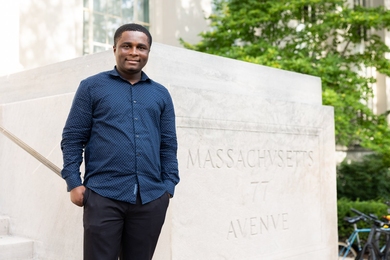Because of medical problems, Paul DeSantis' infant daughter had to take food through a tube into her abdomen, but the feeding system wasn't working as well as it should. So Mr. DeSantis sat down and designed a better one, which has just been patented.
But although MIT scientists and engineers often get their work patented, it is almost certainly the first time a plumber from Physical Plant has done so.
Mr. DeSantis' daughter Ashley was born in 1991 with multiple handicaps, including reflux of stomach acid into her esophagus. Surgeons bypassed her esophagus by making a permanent percutaneous opening in her abdomen so liquid food could flow by gravity from a bottle directly into her stomach. But there was a problem: gas sometimes built up in Ashley's stomach, causing her pain from the pressure and preventing food from flowing smoothly. The only way to relieve it was to disconnect the food bottle from the tube and raise it above the level of the stomach, a tricky operation that risked escape of fluid.
With his knowledge of valves and pipes, Mr. DeSantis thought there had to be a way around the difficulty. So he designed a tubing system incorporating a one-way check valve to prevent liquid from flowing back out of the stomach. Between that valve and the patient, there would be a Y port in which the branch side would end in a ball valve and vent-similar to devices used in heating systems-to allow gas to escape up the tube from the stomach.
When confronted with the problems in feeding his daughter, Mr. DeSantis said, "it seemed so simple-I thought it was impossible that there couldn't be anything out there" that would work better. But he came to realize that he might have a unique perspective on the problem and its solution: "How many plumbers have a daughter with a tube coming out of her stomach?"
During Ashley's first few months when she was frequently hospitalized, Mr. DeSantis "spoke to a lot of doctors and nurses, and they thought it was a great idea," he said. "You have to be there to realize how difficult it is" to feed children like Ashley with existing equipment. His device could be useful for many other people who have food or medicine administered percutaneously, he added. Ashley is now in a home for severely handicapped children, "and half the kids have a [stomach] tube."
During the design phase, Mr. DeSantis got some assistance from Ernesto Blanco, adjunct professor of mechanical engineering, and a team of students in the fall 1994 Total Quality Development class taught by Don Clausing, Bernard M. Gordon Adjunct Professor of Engineering Innovation and Practice. When he first presented his design to the students, "I was kind of nervous in front of all those smart kids, but they were cool-they understood where I was coming from," Mr. DeSantis said.
The Technology Licensing Office, with the help of Cambridge attorney Steven Weissburg, submitted drawings and documents to the US Patent Office; MIT was granted a patent in October. Mr. DeSantis (who lives in Saugus with his wife and two other children) will receive 28 percent of any net financial proceeds from the invention.
He and the TLO have approached various medical equipment companies in the hope that one of them will want to manufacture and market the device now that it is patented. He's hopeful that this fact, coupled with MIT's design reputation, will result in success, though he has not as yet been able to get a prototype of his invention built. "When I say I'm from MIT, their eyes open a little wider," he said with a smile. "I don't tell them I'm a plumber."
A version of this article appeared in MIT Tech Talk on December 13, 1995.





